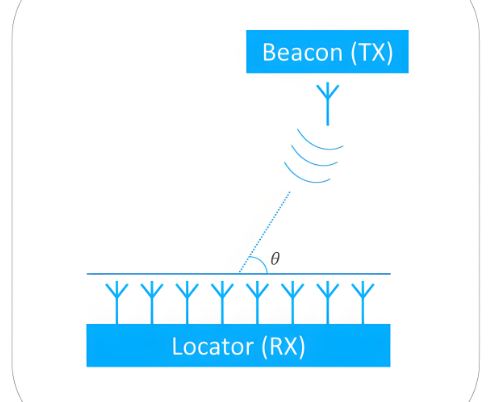In wireless communications, radar detection, sonar positioning, and many other fields involving signal propagation, angle of arrival measurement is a crucial technology. It can help us accurately determine the direction of the signal source and provide a key basis for subsequent positioning, tracking, and signal processing operations. So, what exactly is angle of arrival measurement?

Basic concepts of angle of arrival measurement
Angle of arrival (AOA) refers to the angle between the signal and a reference direction (usually the normal direction of the antenna array) when it propagates from the transmitting source to the receiving antenna array. Angle of arrival measurement is to accurately determine the size of this angle through specific algorithms and technical means. This process involves analyzing and processing parameters such as the phase and amplitude of the received signal to infer the direction of signal propagation.
Main methods of angle of arrival measurement
Beamforming method
Beamforming is an angle of arrival measurement method based on antenna arrays. It adjusts the weighting coefficients of each array element in the antenna array so that the array forms a beam in a specific direction while suppressing signals in other directions. When the beam pointing is consistent with the direction of signal arrival, the strength of the received signal reaches the maximum. By constantly changing the direction of the beam and observing the changes in the received signal strength, the angle of arrival of the signal can be determined. This method is simple in principle, but the amount of calculation is large and the accuracy of the antenna array is required to be high.
Interferometer method
The interferometer method uses the phase difference between the signals received by multiple antennas to measure the angle of arrival. When the signal arrives at the antenna array at different angles, a phase difference will occur between the signals received by different antennas. By measuring these phase differences and combining the geometric structure of the antenna array, the angle of arrival of the signal can be calculated. The interferometer method has high measurement accuracy, but it has strict requirements on the accuracy of phase measurement and is easily interfered by factors such as multipath effects.
Maximum likelihood estimation method
The maximum likelihood estimation method is an angle of arrival measurement method based on statistical theory. It assumes that the statistical characteristics of the received signal are known and estimates the angle of arrival of the signal by maximizing the likelihood function. This method has the best estimation performance in theory, but the computational complexity is high and requires a lot of computing resources and time.
Application areas of angle of arrival measurement
Wireless communication
In wireless communication systems, angle of arrival measurement can be used in smart antenna technology to achieve directional transmission and reception of signals. By determining the arrival angle of the user terminal, the base station can adjust the direction of the antenna beam, improve the coverage and transmission quality of the signal, and reduce interference. In addition, the arrival angle measurement can also be used in indoor positioning systems. By receiving the arrival angle information of the signal through multiple base stations, the user terminal can be accurately positioned.
Radar detection
In radar systems, arrival angle measurement is a key link in target positioning and tracking. By measuring the arrival angle of the target reflection signal, the radar can determine the direction of the target, and combine the distance and speed information to achieve accurate tracking and identification of the target. Arrival angle measurement has a wide range of applications in military reconnaissance, meteorological observation, air traffic control and other fields.
Sonar positioning
Sonar systems use the propagation characteristics of sound waves in water to detect and locate targets. Arrival angle measurement also plays an important role in sonar positioning. By measuring the arrival angle of the sound wave signal, sonar can determine the direction of underwater targets and provide support for submarine navigation, underwater archaeology, marine resource exploration, etc.
Challenges of arrival angle measurement
Multipath effect
In actual environment, signals often do not propagate directly from the transmitting source to the receiving end, but will go through multiple reflections, scattering and other processes to form multipath signals. Multipath signals will cause the phase and amplitude of the received signal to change, thus affecting the accuracy of the arrival angle measurement.
Noise interference
Noise in the environment will interfere with the received signal and reduce the signal-to-noise ratio of the signal. When the noise level is high, the accuracy of the arrival angle measurement will be seriously affected, and may even cause the measurement to fail.
Hardware limitations
Hardware factors such as the performance of the antenna array and the accuracy of phase measurement will also limit the accuracy and reliability of the arrival angle measurement. For example, the array element spacing and directional pattern characteristics of the antenna array will affect the effect of beamforming and phase measurement.
As an important signal processing technology, arrival angle measurement has broad application prospects in many fields. Although there are challenges such as multipath effect, noise interference and hardware limitations in the measurement process, with the continuous development and innovation of technology, I believe that these problems will be gradually solved.